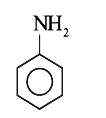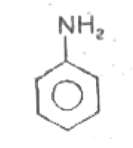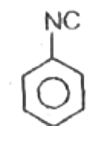Areduction −−−−−→BCHCl3/KOH−−−−−−−−→Creduction −−−−−−→N - methyl aniline then A is


CH3NH2

The correct Answer is:B
To solve the problem step by step, we need to identify compound A based on the given transformations leading to N-methyl aniline.
Step 1: Identify the final product
The final product is N-methyl aniline. This compound has the structure where a methyl group (–CH₃) is attached to the nitrogen atom of an aniline (C₆H₅NH₂) structure.
Step 2: Determine the precursor to N-methyl aniline
To form N-methyl aniline, we can deduce that it is formed from an aniline derivative. The methyl group on nitrogen suggests that the precursor must have a nitrogen atom that can be methylated.
Step 3: Identify the reaction leading to aniline
The question states that there is a reduction step that leads to compound C. Aniline can be produced by the reduction of a nitro group (–NO₂) or a similar nitrogen-containing compound. The most likely precursor for aniline is nitrobenzene (C₆H₅NO₂), which can be reduced to aniline using reducing agents like Sn/HCl.
Step 4: Identify the reaction with CHCl₃ and KOH
The reaction of aniline with CHCl₃ in the presence of KOH is known as the carbylamine reaction, which leads to the formation of N-methyl aniline. In this reaction, the amine group (–NH₂) reacts with chloroform (CHCl₃) and a strong base (KOH) to form a methylated product.
Step 5: Conclusion about compound A
Since we have established that:
- A reduction of nitrobenzene (compound A) leads to aniline (compound B).
- The reaction of aniline with CHCl₃ and KOH leads to N-methyl aniline (compound C).
Thus, compound A is nitrobenzene (C₆H₅NO₂).
Final Answer:
A is nitrobenzene (C₆H₅NO₂).
---
The final product is N-methyl aniline. This compound has the structure where a methyl group (–CH₃) is attached to the nitrogen atom of an aniline (C₆H₅NH₂) structure.
To form N-methyl aniline, we can deduce that it is formed from an aniline derivative. The methyl group on nitrogen suggests that the precursor must have a nitrogen atom that can be methylated.
The question states that there is a reduction step that leads to compound C. Aniline can be produced by the reduction of a nitro group (–NO₂) or a similar nitrogen-containing compound. The most likely precursor for aniline is nitrobenzene (C₆H₅NO₂), which can be reduced to aniline using reducing agents like Sn/HCl.
The reaction of aniline with CHCl₃ in the presence of KOH is known as the carbylamine reaction, which leads to the formation of N-methyl aniline. In this reaction, the amine group (–NH₂) reacts with chloroform (CHCl₃) and a strong base (KOH) to form a methylated product.
Since we have established that:
- A reduction of nitrobenzene (compound A) leads to aniline (compound B).
- The reaction of aniline with CHCl₃ and KOH leads to N-methyl aniline (compound C).
A is nitrobenzene (C₆H₅NO₂).
Similar Questions
Knowledge Check
A underset(अपचयन )overset("reduction")(to) B overset(CHCI_(3)//KOH)(to) C underset(अपचयन )overset("reduction")(to)
N-methyl aniline than A is :A B
B CCH3NH2D
CCH3NH2D
A−Reduction−−−−−→BCHCl3/KOH−−−−−−−−→CReduction−−−−−→
A B
B CCH3NH2D
CCH3NH2D
C2H5BrAgCN−−−→AH3⊕O−−→B+HCOOH
BCHCl3−−−→KOHAReduction−−−−−→C
A,B and C are respectively in this reaction :-AEthane amine, methanenitrile and diethylamineBCarbylamino ethane, ethaneamine and sec. amineCEthyl isocynids, ethylamine and methyl isocyanateDCarbylamino ethane, ethane amine and ethyl methyl amine
In the following sequence of reactions:
C2H5BrAgCN−−−→XReduction−−−−−→Y, Y is:
View SolutionIn the reaction
CHCOOHLiAIH−−−−→APCI5−−−→BalcKOH−−−−−→C
View SolutionC2H5BrAgCN−−−→H3⊕O−−→B+HCOOHBCHCl3−−−−−−→KOHAReduction−−−−−→C A,B, and C are respectively in this reaction:
View SolutionToluene KOH+KMnO−−−−−−−−→APVl5−−→BCH3COONa−−−−−−−→C.
Product ' C is
View SolutionIn the sequence of following reactions : CH3OHHI−−→CH3IKCN−−→CH3CNReduction−−−−−→XHNO2−−−→Y,X and Y are respectively
View Solution
